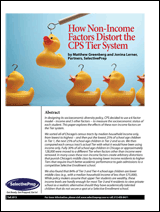How Non-Income Factors Distort the CPS Tier System
August 20, 2012
by Matthew Greenberg and Jonina Lerner
In designing its socioeconomic diversity policy, CPS decided to use a 6 factor model – income and 5 other factors — to measure the socioeconomic status of each student. This paper explores the effects of these non-income factors on the Tier system.
 We sorted all of Chicago’s census tracts by median household income only, from lowest to highest – and then put the lowest 25% of school age children in Tier 1, the next 25% of school age children in Tier 2 and so on. We then compared each census tract’s actual Tier with what it would have been using income only. Fully 30% of all school age children in Chicago or approximately 128,000 were moved to a different Tier when factors other than income were removed. In many cases these non-income factors create arbitrary distortions that punish Chicago’s middle class by moving lower income residents to higher Tiers that require much better academic performance to gain admissions to a competitive Selective Enrollment school.
We sorted all of Chicago’s census tracts by median household income only, from lowest to highest – and then put the lowest 25% of school age children in Tier 1, the next 25% of school age children in Tier 2 and so on. We then compared each census tract’s actual Tier with what it would have been using income only. Fully 30% of all school age children in Chicago or approximately 128,000 were moved to a different Tier when factors other than income were removed. In many cases these non-income factors create arbitrary distortions that punish Chicago’s middle class by moving lower income residents to higher Tiers that require much better academic performance to gain admissions to a competitive Selective Enrollment school.
We also found that 84% of Tier 3 and Tier 4 school age children are lower middle class (e.g., with a median household income of less than $75,000). While policy makers assume that upper Tier students are wealthy, these income levels are hardly enough for most Tier 3 and 4 residents to view private school as a realistic alternative should they have academically talented children that do not secure a spot at a Selective Enrollment school.
